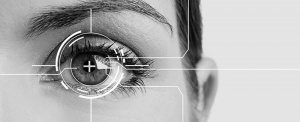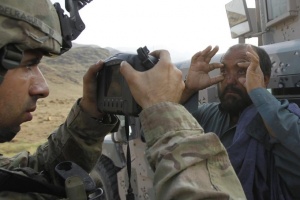Iris Recognition
Iris recognition, as the name suggests, is a biometric verification method that utilizes the unique pattern of each person’s iris, the colored circular structure in the eye, to confirm one’s identity. More explicitly, the authentication process is realized by scanning an iris at a reasonable distance with a near-infrared light and then comparing the acquired template to the already existing templates in a large database system.[1]
Similar to face recognition and fingerprinting, iris recognition uses human biological characteristics to distinguish one person from another. Some find it preferable to the prior two technologies because of the structural attributes of the eye’s iris. These attributes call our attention to identity, privacy, and consent concerns that have come into view gradually as iris recognition is becoming more widely used over time.

Contents
Advantages
Higher Accuracy
Iris recognition is not guaranteed to be perfectly correct all the time and many factors, like changes of lighting and the use of different algorithms, affect accuracy, but it leaves less room for deceit because the iris traits are more permanent and stable, and it is more difficult to change one’s iris than it is to alter other body parts.[3] The high error rate of face recognition is introduced by the change of facial features across conditions and the similarities existing among people like twins.[4] Also the advancement of cosmetic surgery techniques makes face recognition impractical to use in practice. The first documentation of appearance-altering surgery (to help people recover from injuries) can be dated back to more than four thousand years ago, and within the recent decades, more people have adopted cosmetic surgery to change or improve their facial appearance. In addition to altering one's face, there are also multiple ways of altering one’s fingerprints that offer an opportunity for ill-intentioned people to successfully sneak through criminal checkpoints. According to a report in Forensic magazine, the FBI has caught hundreds of suspects who tried to alter their distinctive marks at their fingertips by deep cuts, burning, biting, and using sandpaper to avoid identification.[5]
Remote Scan
Iris recognition is also more efficient because of the way the eye is scanned. While an iris scanner only needs to convert iris patterns to data, and can do so at a considerable distance, face recognition demands close-proximity scanning of many facial parts in order to collect essential features, and fingerprint detection requires people to physically press their fingers onto the machines. And iris recognition is only getting more remote. Researchers at Carnegie Mellon University have increased the distance from which iris recognition is able to work to more than ten meters away from a moving subject. This means in the future it is very possible that an iris recognition surveillance camera can identify people easily at a far distance when they walk by in the airport or glance into the rear-view mirror while driving on the street.[6]
Ethical Issues
Identity
Due to the high accuracy of iris recognition, many countries including the UK and the United Arab States are using this technology as a national ID for citizens and as a passport for travelers. Like Wikipedia bots and cyborgs, which can not only fight against vandalism more effectively than humans but also cause chaos when used inappropriately for users' own interest, the high accuracy of iris recognition imposes serious consequences such as the ease of identity theft by using high-resolution photos of someone else's iris.[7] It is very likely that iris recognition will become a substitute for other legal documents like drivers’ licenses and will be applied to more situations where some sort of ID is required. Irises are not like fake paper documents that can be detected easily. If someone’s iris pattern is stolen, it is potentially more dangerous since it cannot be fixed easily like getting a new Facebook account, and it is impossible for people to get new iris patterns or alter their eyes completely.
Privacy

Up till now, iris recognition has been used mainly by the U.S. military to identify captives taken from foreign battlefields, by police departments to surveil law-breakers, by the Department of Homeland Security to spot suspects on watch lists, and by law enforcement at borders to identify smugglers and terrorists.[6] As more iris data are collected from people and commercial iris scanners become cheaper and more accessible to the general public, iris scanning could be used for stalking of ordinary innocent people even without their noticing it. Imagine walking down the street surrounded by cameras that know about each person who passes by, including who they are, whom they have met, who their friends are, where they have been, and what their daily routines are.[8] Furthermore, with the improvement of resolution techniques, iris recognition can be used to match and combine someone's online and offline identities like how people identify strangers by using face recognition and photos on Facebook in the paper "Face Recognition and Privacy in the Age of Augmented Reality". These technologies are gradually erasing the borderline of people's onlife and offlife, and they call our attention to solving the rising privacy matters.[9]
Consent
The issue of consent relates to the way law enforcement collects iris data. There have been reports from the New York Times that some police officers hold detainees longer than they should merely because those people refuse to have their iris photographs taken. From a security point of view, iris records help police keep track of suspects if they try to escape from charges. As far as most people are concerned, the data might be used to track defendants even after the charge is dropped or the case is closed. In best practices, iris data should be given voluntarily; forcing detainees to scan their irises is problematic, especially in situations where there is no legislative authorization.[10] How iris recognition should be employed definitely demands further serious and ad hoc consideration.
Reference
- ↑ Wildes, Richard. Iris Recognition: an Emerging Biometric Technology - IEEE Journals & Magazine, Sept. 1997, ieeexplore.ieee.org/stamp/stamp.jsp?tp=&arnumber=628669.
- ↑ Thakkar, Danny. “Retinal vs. Iris Recognition: Your Eyes Can Get You Identified?” Bayometric, Bayometric, 8 Aug. 2018, www.bayometric.com/retinal-vs-iris-recognition/.
- ↑ Jain, Anil K., and Sharath Pankanti. “BEYOND FINGERPRINTING.” Scientific American, vol. 299, no. 3, 2008, pp. 78–81. JSTOR, www.jstor.org/stable/26000805.
- ↑ Daugman, John. “Iris Recognition: The Colored Part of the Eye Contains Delicate Patterns That Vary Randomly from Person to Person, Offering a Powerful Means of Identification.” American Scientist, vol. 89, no. 4, 2001, pp. 326–333. JSTOR, www.jstor.org/stable/27857501.
- ↑ Augenstein, Seth. “FBI Warns About Altered Fingerprints.” Forensic Magazine, 14 June 2016, www.forensicmag.com/article/2015/05/fbi-warns-about-altered-fingerprints.
- ↑ 6.0 6.1 6.2 Stone, Jeff. “Iris Scanners, Widely Used By US Military, Could Be Coming To A Police Department Near You.” International Business Times, 12 May 2015, www.ibtimes.com/iris-scanners-widely-used-us-military-could-be-coming-police-department-near-you-1917018.
- ↑ Halfaker, Aaron, and John Riedl. “Bots and Cyborgs: Wikipedia's Immune System.” Computer, vol. 45, no. 3, 2012, pp. 79–82., doi:10.1109/mc.2012.82.
- ↑ Meyer, Robinson. “Long-Range Iris Scanning Is Here (and It's Creepy).” The Atlantic, Atlantic Media Company, 13 May 2015, www.theatlantic.com/technology/archive/2015/05/long-range-iris-scanning-is-here/393065/.
- ↑ Acquisti, A., R. Gross, and F. Stutzman. “Face Recognition and Privacy in the Age of Augmented Reality”. Journal of Privacy and Confidentiality, Vol. 6, no. 2, Dec. 2014, doi:10.29012/jpc.v6i2.638.
- ↑ Moynihan, Colin. “Some Who Decline an Optional Iris Photo Are Kept Longer in Jail, Critics Say.” The New York Times, The New York Times, 13 Feb. 2012, www.nytimes.com/2012/02/13/nyregion/new-objections-to-nypds-iris-photographing-program.html.